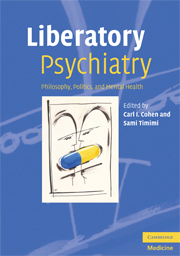Book contents
- Frontmatter
- Contents
- Contributors
- Acknowledgments
- Introduction
- 1 Working towards a liberatory psychiatry? Radicalizing the science of human psychology and behavior
- 2 Power, freedom, and mental health: a postpsychiatry perspective
- 3 Challenging risk: a critique of defensive practice
- 4 Democracy in psychiatry: or why psychiatry needs a new constitution
- 5 German critical psychology as emancipatory psychology
- 6 Psychopolitical validity in the helping professions: applications to research, interventions, case conceptualization, and therapy
- 7 Class exploitation and psychiatric disorders: from status syndrome to capitalist syndrome
- 8 Ecological, individual, ecological? Moving public health psychiatry into a new era
- 9 Children's mental health and the global market: an ecological analysis
- 10 Postcolonial psychiatry: the Empire strikes back? Or, the untapped promise of multiculturalism
- 11 A new psychiatry for a new world: postcolonialism, postmodernism, and the integration of premodern thought into psychiatry
- 12 Neoliberalism and biopsychiatry: a marriage of convenience
- 13 Psychoanalysis and social change: the Latin American experience
- 14 A new psychiatry?
- Index
- References
9 - Children's mental health and the global market: an ecological analysis
Published online by Cambridge University Press: 25 August 2009
- Frontmatter
- Contents
- Contributors
- Acknowledgments
- Introduction
- 1 Working towards a liberatory psychiatry? Radicalizing the science of human psychology and behavior
- 2 Power, freedom, and mental health: a postpsychiatry perspective
- 3 Challenging risk: a critique of defensive practice
- 4 Democracy in psychiatry: or why psychiatry needs a new constitution
- 5 German critical psychology as emancipatory psychology
- 6 Psychopolitical validity in the helping professions: applications to research, interventions, case conceptualization, and therapy
- 7 Class exploitation and psychiatric disorders: from status syndrome to capitalist syndrome
- 8 Ecological, individual, ecological? Moving public health psychiatry into a new era
- 9 Children's mental health and the global market: an ecological analysis
- 10 Postcolonial psychiatry: the Empire strikes back? Or, the untapped promise of multiculturalism
- 11 A new psychiatry for a new world: postcolonialism, postmodernism, and the integration of premodern thought into psychiatry
- 12 Neoliberalism and biopsychiatry: a marriage of convenience
- 13 Psychoanalysis and social change: the Latin American experience
- 14 A new psychiatry?
- Index
- References
Summary
Introduction
Prescriptions of psychotropic medication to children and adolescents have shown a phenomenal increase in most Western countries. For example, the amount of psychotropic medication prescribed to children in the United States increased nearly fourfold between 1985 and 1994 (Pincus et al., 1998). Researchers analyzing prescribing trends in nine countries between 2000 and 2002 found significant rises in the number of prescriptions for psychotropic drugs in children, were evident in all countries – the lowest being in Germany where the increase was 13%, and the highest being in the UK where an increase of 68% was recorded (Wong et al., 2004). Of particular concern is the increase in rates of stimulant prescription to children. By 1996 over 6% of school-aged boys in America were taking stimulant medication (Olfson et al., 2002) with children as young as two being prescribed stimulants in increasing numbers (Zito et al., 2000). Recent surveys show that, in some schools in the United States, over 17% of boys are taking stimulant medication (LeFever et al., 1999) and it is now estimated that about 10% of school boys in the United States take a stimulant (Wallis, 2006). In the UK prescriptions for stimulants have increased from about 6000 in 1994 to over 350,000 children by 2004 (Woolf, 2005), suggesting that we in the UK are rapidly catching up with the USA.
- Type
- Chapter
- Information
- Liberatory PsychiatryPhilosophy, Politics and Mental Health, pp. 163 - 182Publisher: Cambridge University PressPrint publication year: 2008
References
- 1
- Cited by



